外研版(2019)必修 第三册Unit 3 The world of science Developing ideas-reading公开课课件(共22张PPT)
文档属性
| 名称 | 外研版(2019)必修 第三册Unit 3 The world of science Developing ideas-reading公开课课件(共22张PPT) | 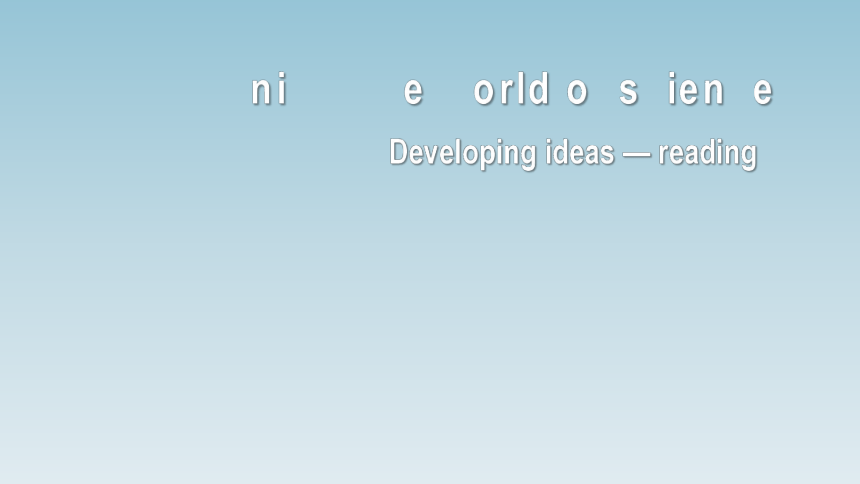 | |
| 格式 | pptx | ||
| 文件大小 | 1.1MB | ||
| 资源类型 | 教案 | ||
| 版本资源 | 外研版(2019) | ||
| 科目 | 英语 | ||
| 更新时间 | 2023-03-01 14:32:52 | ||
图片预览

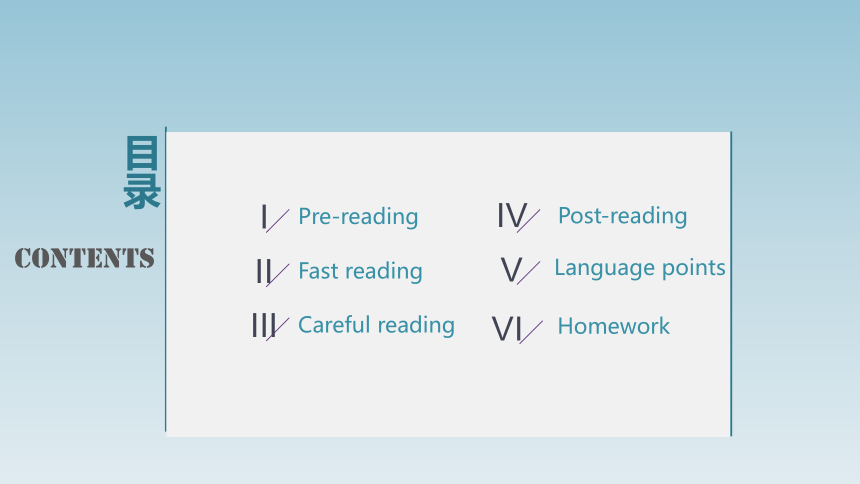
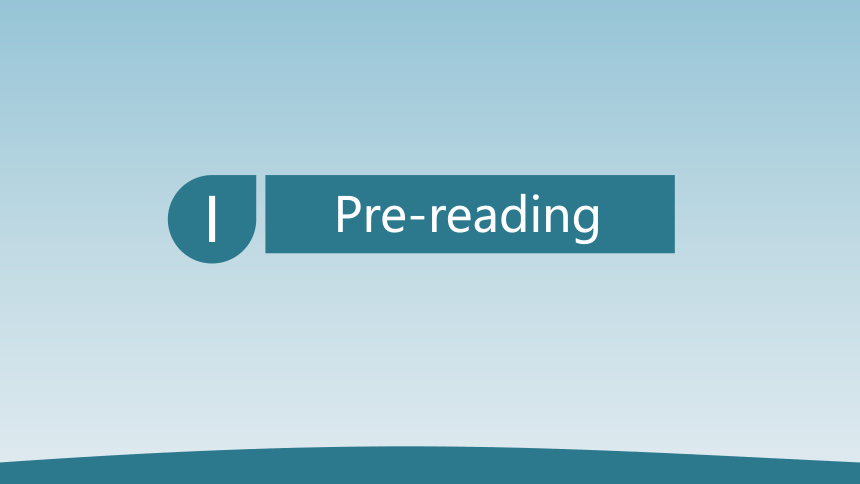
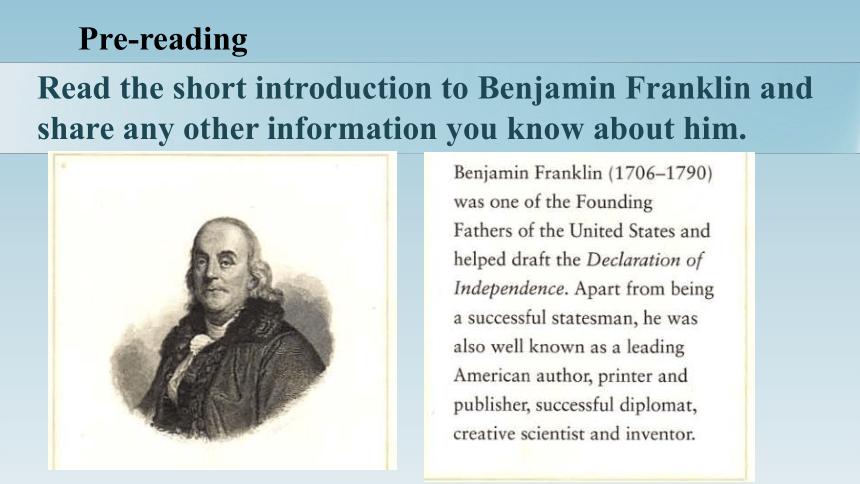

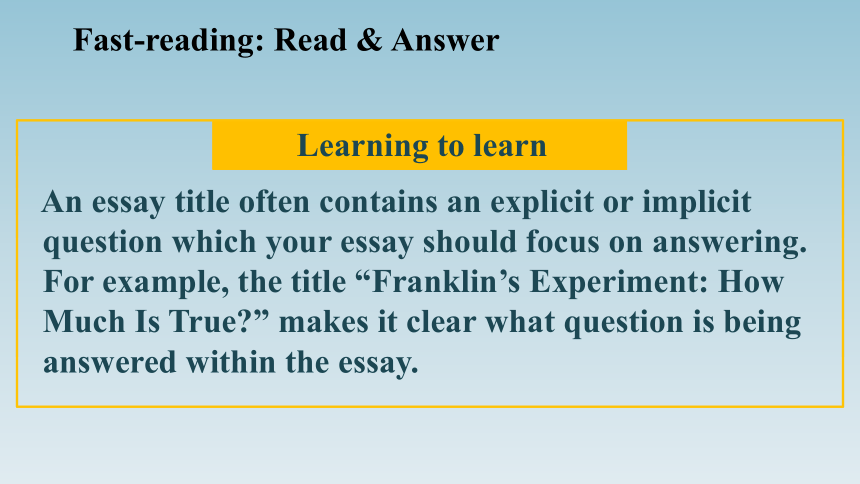
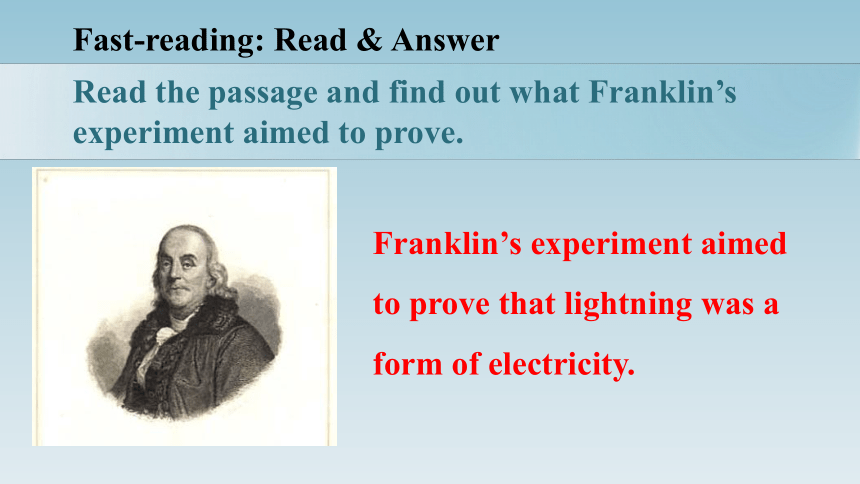
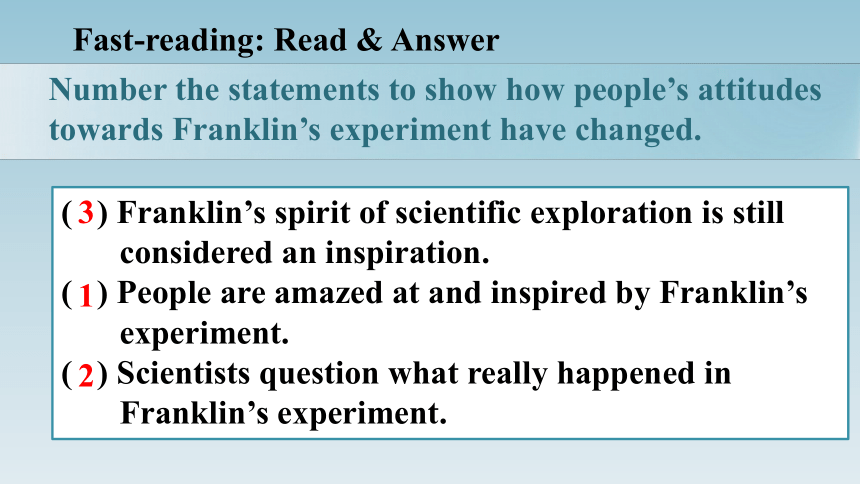
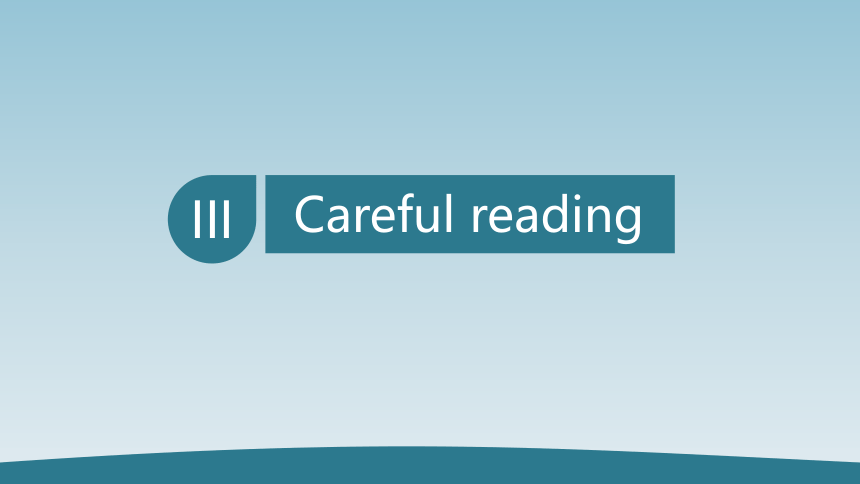
文档简介
(共22张PPT)
Developing ideas — reading
Unit 3 The world of science
目录
contents
Pre-reading
I
Language points
IV
Fast reading
II
Homework
V
Careful reading
III
Post-reading
VI
Pre-reading
I
Pre-reading
Read the short introduction to Benjamin Franklin and share any other information you know about him.
Fast reading
II
Fast-reading: Read & Answer
Learning to learn
An essay title often contains an explicit or implicit
question which your essay should focus on answering.
For example, the title “Franklin’s Experiment: How
Much Is True ” makes it clear what question is being
answered within the essay.
Fast-reading: Read & Answer
Franklin’s experiment aimed to prove that lightning was a form of electricity.
Read the passage and find out what Franklin’s experiment aimed to prove.
( ) Franklin’s spirit of scientific exploration is still
considered an inspiration.
( ) People are amazed at and inspired by Franklin’s
experiment.
( ) Scientists question what really happened in
Franklin’s experiment.
Fast-reading: Read & Answer
Number the statements to show how people’s attitudes towards Franklin’s experiment have changed.
3
1
2
Careful reading
III
Do you think it matters that Franklin’s experiment might not be true Why
What is your opinion about the statement “ ... we should not always believe everything we read or hear — even if it is a great story”
What qualities do you think a great scientist should have
In what ways do scientists contribute to society
Careful reading: Answer the questions
Careful reading: Answer the questions
Post-reading
IV
Work in groups. Explain your understanding of the saying “Seeing is believing”, and then give a talk about it. You may use information in the passage as examples.
1. Make notes about your understanding of the saying and list supporting details.
Post-reading
Post-reading
2. Organise your talk following the steps below.
Start your talk by explaining how you understand
this saying.
Explain why you think this way. Use the notes you
have made to support your ideas.
End your talk by summarising your points.
3. Give your talk to the class.
Language points
V
______________________
______________________
______________________
______________________
______________________
______________________
______________________
______________________
Language Points: Important phrases
1. approach to
2. be amazed by
3. along with
4. in order to
5. neither ... nor ...
6. more than one
7. lead sb to do sth
8. come up with
……的方法
对……感到吃惊
同……一起
为了
既不……也不……
不止一个
导致某人做某事
想出
Language Points: Important sentences
1. He raised the kite with a piece of string tied to it.
句子中 “with a piece of string tied to it ”为with复合结构“with + 名词 / 代词 + 现在分词 / 过去分词 / 不定式”。
a piece of string 与tie是动宾关系,因此用tied。
2. A metal key was attached to the string.
Paraphrase (释义):
A metal key was connected with the string.
attach意为 “to fasten or connect one object to another”用法为 attach sth to sth,把……固定 / 附在……上,其中to为介词。
例如:
Attach a recent photograph to your application form.
申请表上请贴一张近照。
Language Points: Important sentences
3. More than one generation of schoolchildren has been
amazed by his bravery and his scientific approach to
looking for the truth.
more than one意为“不止一个”,其后的谓语动词通常用单数。
approach 为名词,意为“方法(method)”,常用approach to + 名词 / 现在分词表示“……的方法”
例如:He has adopted a new approach to teaching languages. 他采用了新的语言教学方法。
Language Points: Important sentences
4. Admittedly, fiction is often more interesting than
the truth.
admittedly 意为“诚然,确实”常放在句首,表示承认或接受某个事实。
例如:
Admittedly, a lot of problems are my faults.
不可否认,很多问题是我的错。
Language Points: Important sentences
Homework
VI
Homework
Think of another story about a famous inventor and use your words to describe it.
Compared to the past, what has changed to invent things
Developing ideas — reading
Unit 3 The world of science
目录
contents
Pre-reading
I
Language points
IV
Fast reading
II
Homework
V
Careful reading
III
Post-reading
VI
Pre-reading
I
Pre-reading
Read the short introduction to Benjamin Franklin and share any other information you know about him.
Fast reading
II
Fast-reading: Read & Answer
Learning to learn
An essay title often contains an explicit or implicit
question which your essay should focus on answering.
For example, the title “Franklin’s Experiment: How
Much Is True ” makes it clear what question is being
answered within the essay.
Fast-reading: Read & Answer
Franklin’s experiment aimed to prove that lightning was a form of electricity.
Read the passage and find out what Franklin’s experiment aimed to prove.
( ) Franklin’s spirit of scientific exploration is still
considered an inspiration.
( ) People are amazed at and inspired by Franklin’s
experiment.
( ) Scientists question what really happened in
Franklin’s experiment.
Fast-reading: Read & Answer
Number the statements to show how people’s attitudes towards Franklin’s experiment have changed.
3
1
2
Careful reading
III
Do you think it matters that Franklin’s experiment might not be true Why
What is your opinion about the statement “ ... we should not always believe everything we read or hear — even if it is a great story”
What qualities do you think a great scientist should have
In what ways do scientists contribute to society
Careful reading: Answer the questions
Careful reading: Answer the questions
Post-reading
IV
Work in groups. Explain your understanding of the saying “Seeing is believing”, and then give a talk about it. You may use information in the passage as examples.
1. Make notes about your understanding of the saying and list supporting details.
Post-reading
Post-reading
2. Organise your talk following the steps below.
Start your talk by explaining how you understand
this saying.
Explain why you think this way. Use the notes you
have made to support your ideas.
End your talk by summarising your points.
3. Give your talk to the class.
Language points
V
______________________
______________________
______________________
______________________
______________________
______________________
______________________
______________________
Language Points: Important phrases
1. approach to
2. be amazed by
3. along with
4. in order to
5. neither ... nor ...
6. more than one
7. lead sb to do sth
8. come up with
……的方法
对……感到吃惊
同……一起
为了
既不……也不……
不止一个
导致某人做某事
想出
Language Points: Important sentences
1. He raised the kite with a piece of string tied to it.
句子中 “with a piece of string tied to it ”为with复合结构“with + 名词 / 代词 + 现在分词 / 过去分词 / 不定式”。
a piece of string 与tie是动宾关系,因此用tied。
2. A metal key was attached to the string.
Paraphrase (释义):
A metal key was connected with the string.
attach意为 “to fasten or connect one object to another”用法为 attach sth to sth,把……固定 / 附在……上,其中to为介词。
例如:
Attach a recent photograph to your application form.
申请表上请贴一张近照。
Language Points: Important sentences
3. More than one generation of schoolchildren has been
amazed by his bravery and his scientific approach to
looking for the truth.
more than one意为“不止一个”,其后的谓语动词通常用单数。
approach 为名词,意为“方法(method)”,常用approach to + 名词 / 现在分词表示“……的方法”
例如:He has adopted a new approach to teaching languages. 他采用了新的语言教学方法。
Language Points: Important sentences
4. Admittedly, fiction is often more interesting than
the truth.
admittedly 意为“诚然,确实”常放在句首,表示承认或接受某个事实。
例如:
Admittedly, a lot of problems are my faults.
不可否认,很多问题是我的错。
Language Points: Important sentences
Homework
VI
Homework
Think of another story about a famous inventor and use your words to describe it.
Compared to the past, what has changed to invent things
